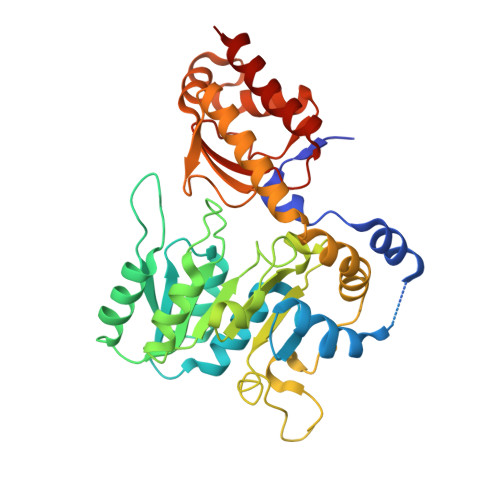Structural Insights into the Second Step of RNA-dependent Cysteine Biosynthesis in Archaea: Crystal Structure of Sep-tRNA:Cys-tRNA Synthase from Archaeoglobus fulgidus
Fukunaga, R., Yokoyama, S.(2007) J Mol Biol 370: 128-141
- PubMed: 17512006
- DOI: https://doi.org/10.1016/j.jmb.2007.04.050
- Primary Citation of Related Structures:
2E7I, 2E7J - PubMed Abstract:
In the ancient organisms, methanogenic archaea, lacking the canonical cysteinyl-tRNA synthetase, Cys-tRNA(Cys) is produced by an indirect pathway, in which O-phosphoseryl-tRNA synthetase ligates O-phosphoserine (Sep) to tRNA(Cys) and Sep-tRNA:Cys-tRNA synthase (SepCysS) converts Sep-tRNA(Cys) to Cys-tRNA(Cys). In this study, the crystal structure of SepCysS from Archaeoglobus fulgidus has been determined at 2.4 A resolution. SepCysS forms a dimer, composed of monomers bearing large and small domains. The large domain harbors the seven-stranded beta-sheet, which is typical of the pyridoxal 5'-phosphate (PLP)-dependent enzymes. In the active site, which is located near the dimer interface, PLP is covalently bound to the side-chain of the conserved Lys209. In the proximity of PLP, a sulfate ion is bound by the side-chains of the conserved Arg79, His103, and Tyr104 residues. The active site is located deep within the large, basic cleft to accommodate Sep-tRNA(Cys). On the basis of the surface electrostatic potential, the amino acid residue conservation mapping, the position of the bound sulfate ion, and the substrate amino acid binding manner in other PLP-dependent enzymes, a binding model of Sep-tRNA(Cys) to SepCysS was constructed. One of the three strictly conserved Cys residues (Cys39, Cys42, or Cys247), of one subunit may play a crucial role in the catalysis in the active site of the other subunit.
Organizational Affiliation:
Department of Biophysics and Biochemistry, Graduate School of Science, University of Tokyo, 7-3-1 Hongo, Bunkyo-ku, Tokyo 113-0033, Japan.
















